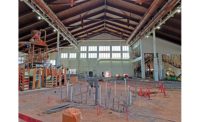"The thinking was to flow forms down the river and incorporate them into existing structure rather than have divers construct formwork in the river," says Benesch project manager Matthew Hellenthal.
But divers did figure into plans for driving into bedrock the 75-ft-long, 6-ft-dia caissons—12 in all—upon which underbridges rest in order to ensure that crews didn't penetrate a subway line extending beneath the river once drilling began. After divers reported the precise locations of subway perimeters, team members further hedged their bets by locating vibration sensors in the tunnel to continuously monitor conditions during operations, Gross says.
Though drillers avoided the subway tunnel, they weren't as lucky with telephone equipment beneath the river that city officials say was undocumented. No major damage occurred, but work was delayed a week while crews regrouped to cut off the caisson, fill it and re-drill a second one several feet away. Operations also were interrupted, from mid-April to mid-May, when a mechanical hammer required to drive steel casing into soil malfunctioned and required replacement.
Once work resumed, it proceeded at a brisk pace. Because caisson drills required that adjacent drawbridges—three in all—be raised, crews were provided only a week to complete work at each location, during which time they worked 24 hours a day.
In each instance, workers first drove casings down to their required elevations, employing a caisson rig to drill out soil from casing interiors to required bearing elevations. Next, cranes lowered full-length circular rebar cages into the casings before operators of a 130-ft-long hose filled them with concrete—about 2,000 cu ft per casing—pumped from mixers on Wacker Drive.
As with other Riverwalk components, liner shells arrived at their locations via barges, the majority of which were loaded at a Walsh company yard southwest of Chicago's Loop, then guided upriver via tugboats. City officials say the completed installations are designed to withstand a hit from even the largest of barges traversing the river. "The objective was to develop a design that engaged all four caissons to resist forces in unison, which we were able to achieve through the detailing of the caps," says Hellenthal.
Work on the underbridges in some instances overlapped with remaining portions of the project, including installation of sheet piles forming the river wall and H-piles that anchor Riverwalk to riverbed, transferring loads to layers of earth capable of supporting it.
Rather than work sequentially, "We essentially built out all three of the rooms simultaneously," Gross says.






Post a comment to this article
Report Abusive Comment